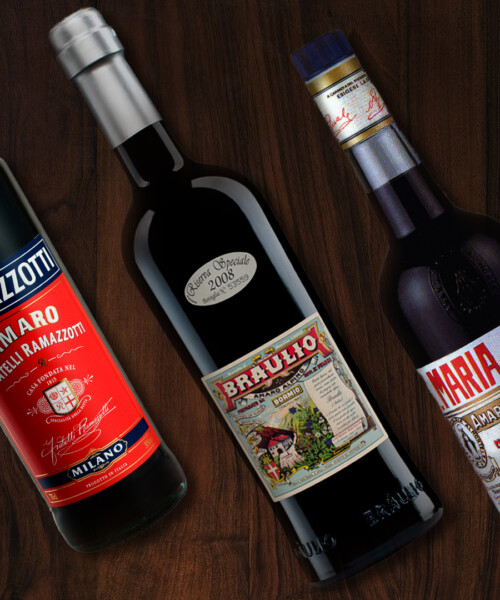It’s no secret that the Negroni—typically equal parts Campari, gin and sweet vermouth—has enjoyed a renaissance among American tipplers. At a time when the apéritif risks being overplayed to extinction, growing appreciation for Italian bitter spirits beyond Campari (and its sweeter cousin Aperol) might be the Negroni’s saving grace.
Time to reach for a bottle of amaro, meaning “bitter” in Italian, a digestif whose deep flavors and earthy aromas render it a suitable match for autumn. Many Europeans tend to sip amari (plural) neat or on the rocks after dinner, but the robust liqueur can be easier—and more fun—to appreciate in a cocktail.
“The complexity [of amari] is interesting to people, particularly when the predominant liqueurs or cordials that were enjoyed for a long time were all pretty one-note and very sweet,” says Jeffrey Morgenthaler, bar manager of Clyde Common and Pépé Le Moko in Portland, Ore., and author of The Bar Book: Elements of Cocktail Technique.“It’s the effect of a new generation exploring new things.”
As with wine varietals, it’s important to know that tremendous differences exist within the amari family. “Just in the same way that a pinot noir from Burgundy is going to be unlike a pinot noir from Oregon,” explains Chauncey Jenkins, of the Lemaire restaurant at the Jefferson Hotel in Richmond, VA, where the in-house cocktail program depends heavily on the liqueur.
The flavor-profile variations among amari, as with wine or Scotch whisky, have largely to do with where it’s made. “Amaro Braulio is made in Bormio, by the Alps, so it’s bark-y and very peppermint-y, and you feel drinking it like you’re in a ski lodge,” says Brynn Smith, bar director of Sotto in LA, which stocks around 30 different types of amari. “And others from Sicily, like Averna, are caramelly, light and a little robust—you can tell that it’s from that kind of a land.”
But unlike wine and most other spirits, the exhaustive lists of ingredients—juniper, anise, fennel, ginger, mint, thyme and citrus fruits, to name just a few—and intricate recipes for most amari are cloaked in secrecy and passed down from one generation to the next. Several brands still in production began in 19th-century pharmacies and monasteries. After all, the distinctive spirit, with styles ranging from light to fernet, has its roots in medicine. So cheers to good health.
Here, 10 quintessential amari, in ascending order of bitterness:
Nonino Quintessentia
Made by a premier grappa-producing family from Fruili, in northern Italy, this lighter amaro is, according to Brynn Smith of Sotto, “the quintessential introduction to amari.”
Montenegro
Dating back to 1885 and named for King Victor Emmanuel III’s marriage to Elena Petrović-Njegoš of Montenegro, this amaro has floral and gentle citrusy top notes.
Averna
Markedly sweet and smooth, with hints of caramel and coffee, Averna, from Caltanissetta, Sicily, is pleasant and not overwhelming.
Meletti
“It tastes like roses,” says Jeffrey Morgenthaler of Clyde Common and Pépé Le Moko in Portland. “And it’s a lot lighter [in color] than Averna or Ramazzotti.” Other noteworthy flavors include anise and saffron.
Cynar
An artichoke-based liqueur—“it tastes nothing like artichokes,” assures Lemaire’s Chauncey Jenkins—Cynar (pronounced “chai-nar”) is infused with 13 herbs and plants. With a mere 16% ABV, it’s adaptable and easy to drink.
Braulio
Created in 1875 by a medicinal chemist in northern Italy, this amaro, fortified with plants, roots and alpine herbs, undergoes a two-year aging process in sessile-oak barrels.
Lucano
This liqueur, produced in the Basilicata region of southern Italy, is dark in color and has aromas of lavender, fennel and cola.
CioCiaro
Bittersweet, vibrant and citrusy, CioCiaro is a popular addition to a broader range of cocktails.
Amaro Ramazzotti
This digestif, from Piedmont, is made from 33 aromatic plants and fruits, including sweet oranges, which give it its primary flavor.
Fernet-Branca
One of the better-known amari, Fernet has a more powerful essence that some have compared to licorice-flavored mouthwash—an acquired taste. It remains one of the most popular spirits in San Francisco.
Brynn Smith’s recipe for an amaro Negroni:
Ingredients:
- 1.5 oz. Martin Miller’s Gin
- 1 oz. (or 3/4 oz. depending on desired bitterness) Cynar, Lucano, CioCiaro or Ramazzotti amaro
- 3/4 oz. Carpano Antica Formula sweet vermouthInstructions:
Pour ingredients into a mixing glass then add ice. Stir with a stirring spoon until cold and diluted. Feel free to straw-taste while mixing. Pour out with a julep strainer up, into a coupe glass, or down, over ice.






































